
Mathemagics Workbook
.pdf
We observe that the approximation is most accurate when the original numbers are close together. Try estimating a 3 x 2 multiplication problem:
By rounding 63 down to 60 and 728 up to 731, you create a 3-by-l multiplication problem, which puts your guesstimate within 2004 of the exact answer, an error of 4.3%.
Now try guesstimating the following 3-by-3 problem:
You will notice that although you rounded both numbers up and down by 8, your guesstimate is off by over 1000. That's because the multiplication problem is larger and the size of the rounding number is larger, so the resulting estimate will be off by a greater amount. But the relative error is still under 1 %.
How high can you go with this system of guesstimating multiplication problems? As high as you want. You just need to know the names of large numbers. A thousand thousand is a million, and a thousand million is a billion. Knowing these names and numbers, try this one on for size:
As before, the objective is to round the numbers to simpler numbers such as 29,000,000 and 14,000. Dropping the 0s for now, this is just a 2-by-2 multiplication problem: 29 x 14 = 406 (29 x 14 = 29 x 7 x 2 = 203 x 2 = 406). Hence the answer is roughly 406 billion, since a thousand million is a billion.
MOD SUMS (CASTING OUT 9'S)
Sometimes, when I do my math on paper, I check my answer by a method 1 call "mod sums" (because it is based on the elegant mathematics of modular arithmetic).
54

With the mod sums method, you sum the digits of each number until you are left with a single digit. For example, to compute the mod sum of 4328, add 4 + 3 + 2 + 8 = 17. Then add the digits of 17 to get 1 + 7 = 8. Hence the mod sum of 4328 is 8. For the following problem the mod sums of each number are computed as follows:
As illustrated above, the next step is to add all the mod sums together (8 + 2 + 8 + 1 + 5 + 5). This yields 29, which sums to 11, which in turn sums to 2. Note that the mod sum of 8651, your original total of the original digits, is also 2. This is not a coincidence! If you've computed the answer and the mod sums correctly, your final mod sums must be the same. If they are different, you have definitely made a mistake somewhere. There is a 1 in 9 chance that the mod sums will match accidentally. If there is a mistake then this method will detect it 8 times out of 9.
The mod sum method is more commonly known to mathematicians and accountants as "casting out 9s" because the mod sum of a number happens to be equal to the remainder obtained when the number is divided by 9. In the case of the answer above—8651—the mod sum was 2. If you divide 8651 by 9 the answer is 961 with a remainder of 2. In other words, if you cast out 9 from 8651 a total of 961 times, you'll have a remainder of 2. There's one small exception to this. The sum of the digits of any multiple of 9 is also a multiple of 9. Thus, if a number is a multiple of 9 it will have a mod sum of 9, even though it has a remainder of 0.
You can also use mod sums to check your answers to subtraction problems. The key is to subtract the mod sums you arrive at and then compare that number to the mod sum of your answer.
55
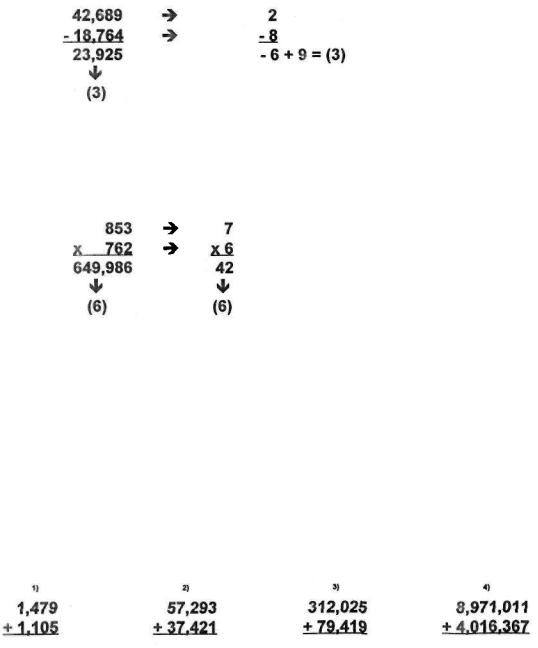
There's one extra twist. If the difference in the mod sums is a negative number or 0, add 9 to it. For instance:
You can check your answers to multiplication problems with the mod sum method by multiplying the mod sums of the two numbers and computing the resulting number's mod sum. Compare this number to the mod sum of the answer. They should match. For example:
If the mod sums don't match, you made a mistake. This method will detect mistakes, on average, 8 times out of 9.
GUESSTIMATION EXERCISES
Go through the following exercises for guesstimation math; then check your answers and computations with ours at the back of the book.
Exercises: Addition Guesstimation
Round these numbers up or down and see how close you can come to the exact answer.
56

Mentally estimate the total for the following column of price numbers by rounding to the nearest 500:
Exercises: Subtraction Guesstimation
Estimate the following subtraction problems by rounding to the second or third digit.
Exercises: Division Guesstimation
Adjust the numbers in a way that allows you to guesstimate the following division problems.
57
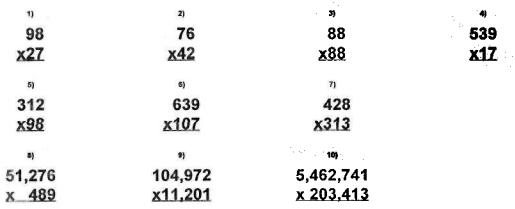
Exercises: Multiplication Guesstimation
Adjust the numbers in a way that allows you to guesstimate the following multiplication problems.
58
CHAPTER 6 INTRODUCTORY ALGEBRA AND SAT MATH
Playing with numbers has brought me great joy in life. I find that arithmetic can be just as entertaining as magic. But to understand the magical secrets of arithmetic requires algebra. Of course, there are other reasons to learn algebra (SAT's, modelling real world problems, computer programming, to name but a few), but what got me first interested in algebra was the desire to understand some mathematical magic tricks which I now present to you!
PSYCHIC MATH
Say to a volunteer in the audience, "Think of a number, any number, but to make it easy on yourself," you should say, "think of a 1-digit or 2-digit number." After you've reminded your volunteer that there's no way you could know his number, ask him to:
1.Double the number.
2.Add 12.
3.Divide the total by 2.
4.Subtract the original number.
Then say, "Was the answer you got by any chance the number 6?" Try this one on yourself first and you will see that the sequence always produces the number 6 no matter what number is originally selected.
59
For example, if the original number is 15.
1.2 x 1 5 = 30
2.30+12 = 42
3.4 2 / 2 = 21
•
4. 21-15 = 6
Why This Trick Works
Let us represent the original number by the letter y. Here are the functions you performed in the order you performed them:
1 . |
2 y |
2.2y+12
3.(2y+12)/2 = y + 6
4.y + 6 - y = 6
So no matter what number your volunteer chooses, the final answer will always be 6. If you repeat this trick, have the volunteer add a different number at step 2 (say 18). The final answer will be half that number (2 x 15 = 30; 30 + 18 = 48; 48 + 2 = 24; 24 - 15 = 9).
THE MAGIC 1089!
Have your audience member take out a piece of paper and pencil and:
1. Secretly write down a 3-digit number in which the first digit is larger than the last digit.
2.Reverse that number and subtract it from the first number. If the result is 2-digit number, tell her to put a 0 in front of it.
3.Take that answer and add it to the reverse of itself.
At the end of this sequence your answer, 1089, will magically appear, no matter what number you originally chose. For example:
60
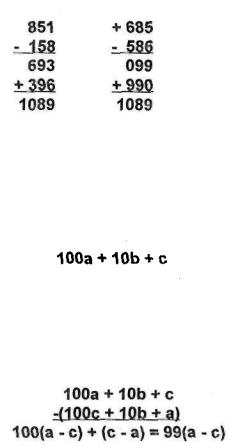
Why This Trick Works
No matter what 3-digit number you or anyone else chooses in this game, the final result will always be 1089. Why? Let abc denote the unknown 3-digit number. Algebraically, this is equal to:
When you reverse the number and subtract it from the original number you get the number cba, algebraically equal to:
Hence, after subtracting in step 2, we must have one of the following multiples of 99: 099, 198, 297, 396, 495, 594, 693, 792, or 891, each one of which will produce 1089 after adding it to the reverse of itself, as we did in step 3.
LEAPFROG ADDITION
This trick combines a quick mental calculation with an astonishing prediction. Handing the spectator a card with ten lines, numbered 1 through 10, have the spectator think of two positive numbers between 1 and 20, and enter them on lines 1 and 2 of the card. Next have the spectator write the sum of lines 1 and 2 on line 3, then the sum of lines 2 and 3 on line 4, and so on as illustrated below.
61
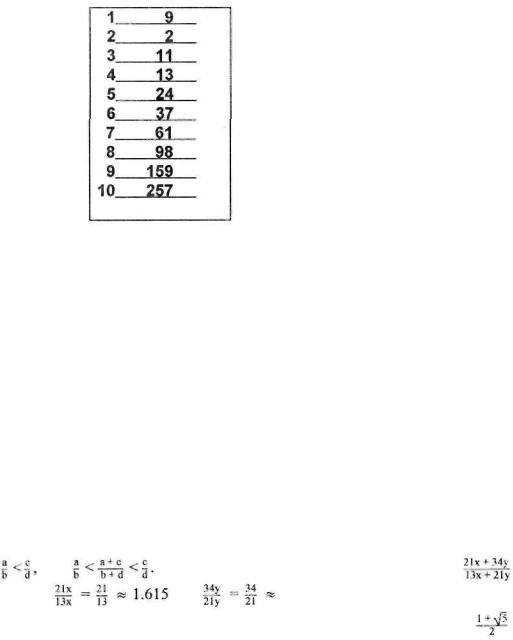
Finally, have the spectator show you the card. At a glance, you can tell him the sum of all the numbers on the card. For instance, in our example, you could instantly announce that the numbers sum up to 671, faster than the spectator could do using a calculator! As a kicker, hand the spectator a calculator, and ask him to divide the number on line 10 by the number on line 9. In our example, the quotient  = 1.616. Have the
= 1.616. Have the
spectator announce the first three digits of the quotient, then turn the card over. He 11 be surprised to see that you've already written the number 1.61!
Why This Trick Works
To perform the quick calculation, you simply multiply the number on line 7 by 11. Here 61 x 11 = 671. The reason this works is illustrated in the table below. If we denote the numbers on lines 1 and 2 by x and y respectively, then the sum of lines 1 through 10 must be 55x + 88y, which equals 11 times (5x + 8y), that is eleven times the number on line 7. As for the prediction, we exploit the fact that for any positive numbers,
a, b, c, d, if |
then |
Thus the quotient of line 10 divided by line 9, |
|
, must lie between |
and |
1.619. In fact, if you continue the |
|
leapfrog process indefinitely, the ratio of consecutive terms gets closer and closer to
 1.618, a number with so many beautiful and mysterious properties that it is often called the "golden ratio."
1.618, a number with so many beautiful and mysterious properties that it is often called the "golden ratio."
62
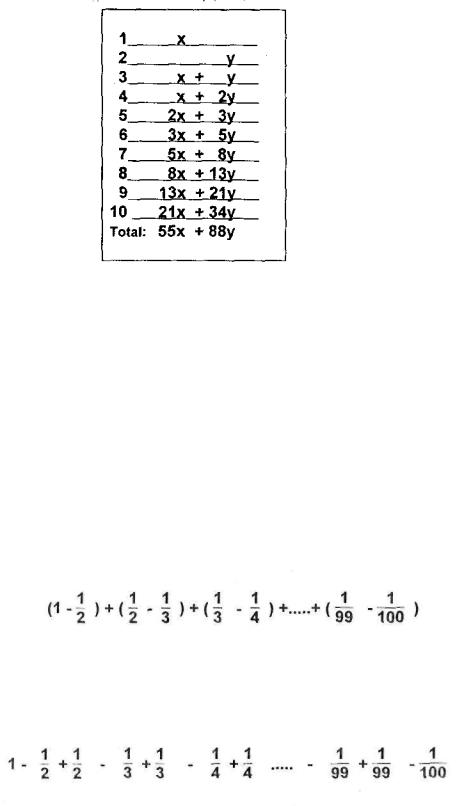
MATHEMAGICS AND SAT MATH
Mastering Mathemagics may help students taking the SAT, an entrance exam required by many colleges. Even in its latest version, the mathematical reasoning section of the SAT still requires an understanding of basic arithmetic, but does not ask questions that require long tedious calculations. In fact, you are even allowed (and encouraged) to use a calculator during the exam. There is greater emphasis on mathematical reasoning rather than laborious computation. The Mathemagics user is encouraged to explore creative solutions to problems. Look at your numbers. Are there special features of the problem that you can exploit?
As an introduction, can you see a clever way to add,
Don't let the parentheses fool you. Since addition is associative, we can rewrite the problem as,
63
